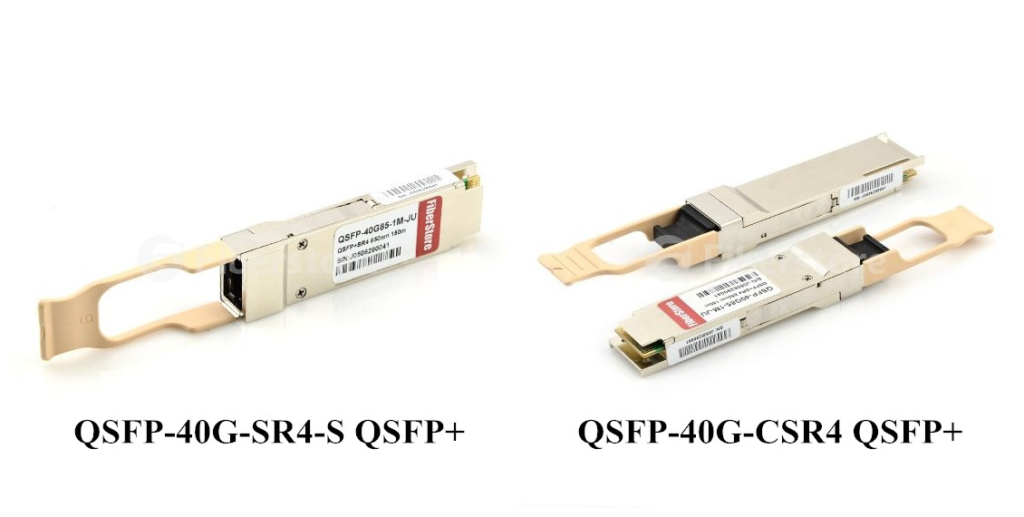In today’s telecommunication markets, Cisco 40GBASE QSFP+ modules offer customers a wide variety of high-density and low-power 40 Gigabit Ethernet connectivity options for data center, high-performance computing networks, enterprise core and distribution layers, as well as service provider transport applications. In order to help customers have a deeper understanding about the 40G QSFP+ modules, this article will introduce several kinds of connectivity options provided by Cisco.
Main features of Cisco 40GBASE QSFP+ modules include:
- Interoperable with other IEEE-compliant 40GBASE interfaces
- Hot-swappable input/output device that plugs into a 40 Gigabit Ethernet Cisco QSFP+ port
- High-speed electrical interface compliant to the IEEE 802.3ba standard
- Compliant to SFF 8436 and QSFP Multisource Agreement (MSA)
Cisco 40GBASE-SR4 QSFP+ module supports link lengths of 100m and 150m respectively on laser-optimized OM3 and OM4 multimode fiber cables. It primarily enables high-bandwidth 40G optical links over 12-fiber ribbon r cables terminated with MPO/MTP multi-fiber connectors. It can also be used in 4x10G mode along with ribbon to duplex fiber breakout cables for connectivity to four 10GBASE-SR optical interfaces. Cisco QSFP-40G-SR4-S is optimized to guarantee interoperability with any IEEE-compliant 40GBase-SR4 module.
Cisco 40GBASE-CSR4 QSFP+ module extends the reach of the IEEE 40GBASE-SR4 interface to 300m and 400m respectively on laser-optimized OM3 and OM4 multimode fiber cables. Each 10-gigabit lane of this module is compliant to IEEE 10GBASE-SR specifications. This module can be used for native 40G optical links over 12-fiber ribbon cables with MPO/MTP connectors, or in a 4x10G mode with ribbon to duplex fiber breakout cables for connectivity to four 10GBASE-SR interfaces. The following picture shows a Cisco QSFP-40G-SR4-S QSFP+ module and a Cisco QSFP-40G-CSR4 QSFP+ module.

Cisco 40GBASE-LR4 QSFP module supports link lengths of up to 10 km over a standard pair of G.652 single-mode fiber with duplex LC connectors. QSFP-40G-LR4-S module supports 40GBase Ethernet rate only. 40 Gigabit Ethernet signal is carried over four wavelengths. Multiplexing and demultiplexing of the four wavelengths are managed in the device. QSFP-40G-LR4-S does not support FCoE.
Cisco WSP-Q40GLR4L QSFP+ module supports link lengths of up to 2 km over a standard pair of G.652 single-mode fiber (SMF) with duplex LC connectors. 40 Gigabit Ethernet signal is carried over four wavelengths. It is interoperable with 40GBase-LR4 for distances up to 2 kilometers.
Cisco QSFP+ copper DACs include QSFP+ to QSFP+ copper DACs and QSFP+ to 4SFP+ copper DACs. Cisco QSFP+ copper DACs are suitable for very short distances and offer a very cost-effective way to establish a 40-gigabit link between QSFP+ ports of Cisco switches within racks and across adjacent racks. QSFP+ to 4SFP+ copper breakout DACs cables connect to a 40G QSFP+ port of a Cisco switch on one end and to four 10G SFP+ ports of a Cisco switch on the other end.
Cisco QSFP+ AOCs include QSFP+ to QSFP+ AOCs and QSFP+ to 4SFP+ AOCs. Active optical cables are much thinner and lighter than copper cables, which makes cabling easier. Active optical cables enable efficient system airflow and have no electromagnetic interference (EMI) issues, which is critical in high-density racks.
Cisco 40G QSFP+ portfolio also cover many other products like Cisco QSFP-40G-SR-BD, Cisco QSFP-40G-BD-RX, Cisco QSFP-40G-ER4, etc. As a professional manufacturer and supplier for optical fiber products, FS.COM provides various kinds of 40GBase QSFP+ transceivers branded by many famous companies. Cisco QSFP+ transceivers offered by FS.COM are the most cost-effective standards-based QSFP+ modules fully compatible with Cisco switches and routers. They are 100% compatible with major brands and backed by a lifetime warranty.












